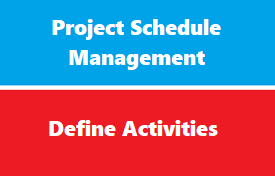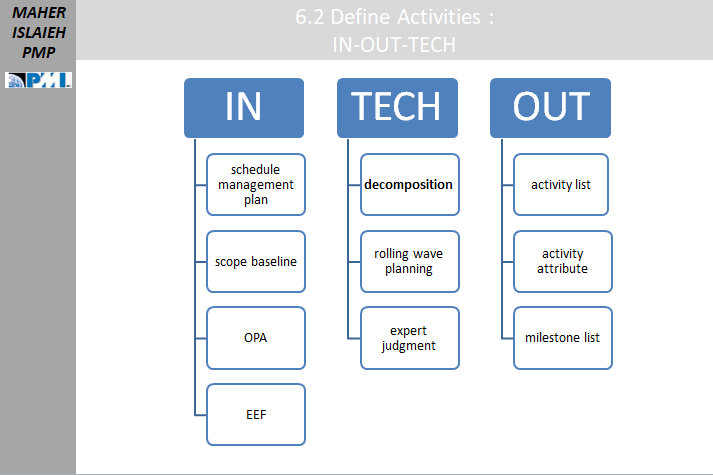introduction
Defining activities is the process of breaking down each deliverable into specific actions which will directly support the accomplishment of that deliverable, as outlined in the WBS
Breaking down each deliverable makes it possible to establish the budget and set the project timeline. With the detail established, monitoring and controlling of each activity is possible.
work package vs activates
Creating Work Packages is completed in the scope of Scope Management knowledge area but, these work packages are turned into activities in Time Management knowledge area in the Define Activities process
Work packages show a small deliverable or work that needs to be completed
Work packages are broken down into activities in order to be better estimated, scheduled, monitored and managed.
activities are usually as small as to be completed in hours or in days.
these activities will be performed by project team members and they should be as small as possible in order to manage and project better.
Schedule Network Diagram
Schedule Network Diagram
- the main benefit of sequence activity is (schedule Network Diagram )
- A network diagram does help you track flow, but it should be the flow of the work, not information. The network diagram has nothing to do with cost or reward systems. The network diagram helps you know when work on the project should be done and in what order
Define Activities: Inputs
Project Management Plan
The components of the project management plan that will be inputs to this process are:
- Schedule management plan–this is the knowledge area management plan related to the schedule, and it will contain guidelines for taking the WBS, part of the scope baseline that is an output of the 5.4 Create WBS process, and using it to create the output of this process 6.2 Define Activities, namely, the activity list.
- Scope baseline–one of the baselines for the major constraints of the project (scope, time, and cost). It is not one document, but three altogether: the project scope document (which contains the scope broken down from the customer requirements to the deliverables that will fulfill them), and the WBS (the work breakdown structure which further breaks down the scope down to the level of work packages) and WBS dictionary (which contains information about the constraints or other important details associated which each work package).
Enterprise Environmental Factors
- Organizational cultures and structure (this will affect which scheduling methodology will be used on the project, for example, and how decisions are made regarding the schedule)
- Published commercial information from commercial databases (this helps create activity lists from work packages which are standard for the industry and type of project you are working on)
- Project management information system (PMIS)–remember, PMI considers the software such as Microsoft Project and to be an enterprise environmental factor because it is something which is created by another company, but the actual data, that is, project documents from previous projects, are part of the organizational process assets (see below)
Organizational Process Assets
- Templates, standardized processes, and schedule planning-related policies, procedures, and guidelines (which should be incorporated into the overall Scope Management Plan)
- Lessons learned repository (especially those entries related to lessons learned about how to create the schedule)
- Historical information (i.e., activity lists from previous similar projects)
Define Activities : techniques
Decomposing
- decomposing work packages into small activity
- some project manager (also MS project Professional ) combine this effort into WBS as one process
Rolling Wave Planning :
- planning first phases at lower level in details , and later phases at higher level , then wait project to get in advance to plan later phases at more details
define activities outputs
Activity List
- The primary output of the Define Activities process is Activity List.
- Activity list includes the project activities that need to be performed in order to complete the project scope.
- This list includes activity names briefly such as install database, configure the database, execute creation scripts etc.
Activity attributes
- Activity attributes is another output of Define Activities process and it complements the activity list. WBS ID of the activity, predecessors or successors of activity, leads, and lags are highlighted in the activity attributes of each activity.
Milestones
- The last output of Define Activities process is Milestones.
- Milestones are not an activity and generally not assigned to any resource.
- But they reflect a significant point in the project.
- For a software project, sample milestones can be the completion of the analysis,
- the completion of design and development, the completion of tests, handover to customer etc.
Change Requests
If progressive elaboration is used as a planning technique, then after the initial iteration of the plan, additional levels of activities may be uncovered in further iterations. In this case, activities are added to the activity list through a change request. Since these activities will add time and cost to the project, the project baselines will also be changed (see the following paragraph.)
Project Management Plan Updates
The baselines of the project, which are part of the project management plan, may be changed whenever additional activities are added to the activity list.
- Schedule baseline–as work packages are progressively elaborated into activities, work may be revealed which was not part of the initial schedule baseline, in which case the schedule baseline may also need to be changed
- Cost baseline–if additional activities are added to the activity list, then the cost associates with these activities may also require changes to the cost baseline


